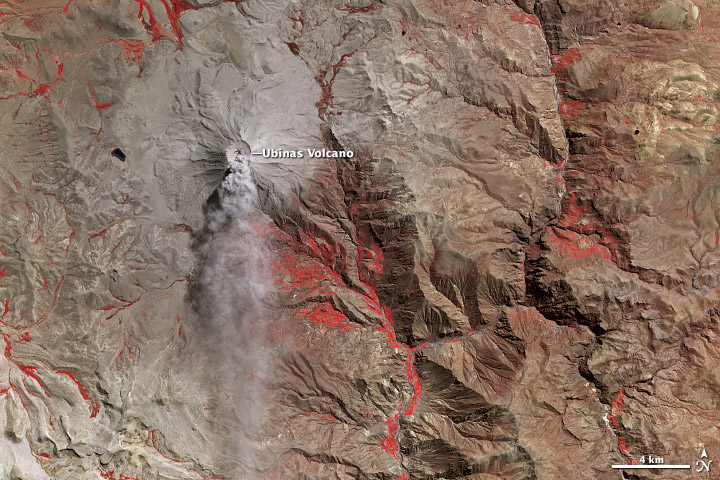The Terra Team extends congratulations to the selected proposals for the Science of Terra and Aqua. Fifty-six proposals were selected out of a total of 212 proposals submitted. Full list including abstracts
This solicitation followed from a 2009 NASA Research Opportunities in Space and Earth Science (ROSES) Program Element. The Science of Terra and Aqua and provided an opportunity for scientists to undertake significant studies responsive to NASA’s and the Science Mission Directorate’s science objectives and the NASA Earth Science Research objectives through the use of data and derived products from two EOS satellites, Terra and Aqua, and their measurement sensors. It represented a continuation of the research aspects of the EOS Instrument Teams for these satellites, emphasized new opportunities for scientists to analyze and exploit EOS data, as well as develop new products by combining multisensor and multiplatform data or by developing an innovative approach to data retrievals. This solicitation offered investigators an opportunity to conduct integrative research projects using the data and products resulting from these satellites and to become involved in the utilization of EOS data to provide answers to NASA’s Earth Science Research questions.
Three types of research were solicited including: Science Data Analysis, Algorithms–New Data Products, Real- or Near-Real-Time Data Algorithms. The Terra Project Science Office welcomes those scientists new to Terra and welcomes back those who have made the Terra mission the great success that it is.
Selected Proposals
Steven Ackerman, University of Wisconsin – Madison
An Algorithm to Determine the Spatial and Temporal Distributions of Sea-Ice Leads in the Arctic
William Balch, Bigelow Laboratory for Ocean Sciences
Science Data Analysis: Integrating the MODIS PIC Product Into the Climate Data Record
Michael Behrenfeld, Oregon State University
Global Ocean Phytoplankton Carbon and Physiology With MODIS Aqua
Ludovic Brucker, Universities Space Research Association, Columbia
Satellite Rain-On-Snow Detection: A New Climate Change Product
Ludovic Brucker, Universities Space Research Association, Columbia
Enhancing the Utility of the AMSR-E NASA Team 2 Sea Ice Concentration Product With Uncertainty and Variability Estimates
Mian Chin, Goddard Space Flight Center
Effects of Volcanic Eruptions on Climate and Environment-A Global Model Study With Satellite Data Constrained Source Functions
Josefino Comiso, Goddard Space Flight Center
Assessing the Magnitude of Change in the Arctic using Multisensor Satellite Data
Wade Crow, USDA ARS
Integrating Microwave and Thermal Remote Sensing for Continuous Dual Source Surface Energy Balance Modeling
Merritt Deeter, National Center for Atmospheric Research
Assimilation and Analysis of Terra Observations of Amazonian Biomass Burning Emissions
Sergio DeSouza-Machado, University of Maryland, Baltimore County
Climate Studies Using Time Evolution of Probability Distribution Functions From 10+ years of AIRS Radiance Measurements
Larry Di Girolamo, University of Illinois at Urbana-Champaign
A Corrected Global View of the Spatial and Temporal Variability in Cloud Drop Effective Radius Through MODIS and MISR Fusion
Scott Doney, Woods Hole Oceanographic Institution
Multi-Scale Satellite Analysis of the Biophysical Dynamics Governing Ocean Phytoplankton Community Structure
Steve Frolking, University of New Hampshire
Incorporating a New Urban Dataset From SeaWinds Into a Multi-Sensor Analysis of Global Daytime and Nighttime Urban Heat Islands
Robert Frouin, Scripps Institution of Oceanography, UCSD
Retrieval of Marine Reflectance From MISR Data
Feng Gao, USDA-ARS
Fusing MODIS, Landsat and Geostationary Data for Daily Monitoring of Crop Condition and Water Use at Field Scales
Dennis Hartmann, University of Washington
Multi-Instrument Characterization of Clouds
Geoffrey Henebry, South Dakota State University
Change in Our MIDST: Detection and Analysis of Land Surface Dynamics in North and South America Using Multiple Sensor Datastreams
Shu-peng Ho, University Corporation for Atmospheric Research
A New Reprocessing Scheme to Improve the Aqua AIRS Global Temperature and Water Vapor Retrievals in the Lower Troposphere and Stratosphere Using GPS Radio Occultation Measurements
Simon Hook, Jet Propulsion Laboratory
Characterizing and Understanding the Impact of Climate Warming on Large Inland Water Bodies
N. Christina Hsu, Goddard Space Flight Center
High-Resolution, Enhanced MODIS Deep Blue Aerosol Products for Cloud-Free and Cloudy Conditions
Chuanmin Hu, University of South Florida
Maximize MODIS Potentials for Near Real-Time Ocean Applications Through Developing and Refining Novel Algorithms and Products
Chuanmin Hu, University of South Florida
Establish a Multi-Sensor Climate Data Record of Ocean Chlorophyll-A Concentrations Using a Novel Algorithm Concept
HL Huang, University of Wisconsin-Madison
International MODIS/AIRS Processing Package (IMAPP) Maintenance and Development of Real-Time Applications and Operational Usage of Terra and Aqua Direct Broadcast Products
Xianglei Huang, University Of Michigan – Ann Arbor
The Synergy Between Longwave Band-by-Band Radiation Budget From AIRS and CERES and Other A-Train Cloud Products in Evaluating Reanalysis Data and GCMs: Connecting Biases in Longwave Radiation Fields and in Cloud Fields
Karl Huemmrich, University of Maryland Baltimore County
Defining a MODIS Light Use Efficiency Product
Glynn Hulley, Jet Propulsion Laboratory
A New MODIS (MOD21) Land Surface Temperature and Spectral Emissivity Product for Earth Science Research
Fredrick Irion, Jet Propulsion Laboratory
Single-Footprint Retrievals of Water Vapor Profiles and Cloud Properties From AIRS
Brian Kahn, Jet Propulsion Laboratory
Advancing Ice Cloud Property Retrievals From AIRS and the A-train
Terry Kubar, Colorado State University
Radiative and Large-Scale Forcing of Tropical Clouds and Their Controls on High SST Environments Using Multi-Sensor Aqua and ECMWF-Reanalysis Datasets
ZhongPing Lee, University of Massachusetts Boston
Development of New Solar Radiation and Primary Production Products from MODIS Ocean-Color Measurements
Ira Leifer, Bubbleology Research International
Long-Term Satellite Data Fusion Observations of Arctic Ice Cover and Methane as a Climate Change Feedback<
Shunlin Liang, University of Maryland
Producing Incident Shortwave Radiation and Photosynthetically Active Radiation Products Over Land Surfaces From MODIS and Multiple Geostationary Satellite Data
Alexei Lyapustin, Goddard Space Flight Center
Advancing MODIS Climate Data Records with Algorithm MAIAC
Alexander Marshak, Goddard Space Flight Center
Study of Aerosol Properties in the Vicinity of Clouds Using Multiplatform and Multisensor Data Fusion
Peter Minnett, University of Miami, RSMAS
The Forward Solution to Sea-Surface Temperature Retrieval From MODIS Measurements
Karen Mohr, Goddard Space Flight Center
A Multi-Scale Investigation of the Structure and Dynamics of the Saharan Air Layer and Its Interactions With Tropical Waves
Lazaros Oreopoulos, Goddard Space Flight Center
Understanding the Links Between Clouds and Their Environment by Employing MODIS Cloud Regimes in Compositing Studies
David Pieri, Jet Propulsion Laboratory
Mining the ASTER Volcano Archive (AVA): The New Global Volcanology (ASTER Science Team Renewal)
Fritz Policelli, Goddard Space Flight Center
Near Real-Time Surface Water Extent and Flood Mapping
Volker Radeloff, University of Wisconsin-Madison
Developing and Testing the Dynamic Habitat Index From Terra and Aqua MODIS Data for Biodiversity and Conservation Science
Michael Ramsey, University of Pittsburgh
Near-Real Time Data Acquisition and Modeling of Volcanic Processes Using a Multi-Instrument Approach: Affects on Climate, the Solid Earth and the Prospect of Eruption Forecasting
Oreste Reale, Universities Space Research Association
Using AIRS Data to Understand Processes Affecting Tropical Cyclone Structure and Extreme Precipitation in a Global Data Assimilation and Forecasting Framework
Jason Roberts, Marshall Space Flight Center
Coupled Atmosphere-Ocean Interactions in the Suppressed Phase of the Madden-Julian Oscillation Using a Multiplatform Strategy
David Santek, University of Wisconsin-Madison
Real-Time Generation of Atmospheric Motion Vectors From AIRS Retrieval Data
JoelSusskind, Goddard Space Flight Center
Development, Validation, and Scientific Evaluation of a Multi-Year Sounder Based Climate Data Set Using Products Derived From AIRS/AMSU, CERES, MODIS, and TOVS Observations
Bastiaan van Diedenhoven, Goddard Institute for Space Studies
Global Variation of the Fundamental Radiative Properties of Ice Clouds
Tomislava Vukicevic, Atlantic Oceanographic and Meteorological
Laboratories Evaluating and Comparing Assimilation of AIRS Cloudy and Cloud-Clear Radiances and Retrievals in Tropical Cyclone (TC) Data Analysis and Their Impact on TC Prediction
Juying Warner, University of Maryland
New Daily Global Products of N2O and HNO3 From AIRS
Paul Werdell, Goddard Space Flight Center
Advancing the Retrieval of Marine Inherent Optical Properties From Satellite Ocean Color Radiometry
Toby Westberry, Oregon State University
A Next-Generation Net Primary Production Model for Application to MODIS Aqua
Curtis Woodcock, Boston University
Near Real-Time Monitoring of Land Cover Disturbance by Fusion of MODIS and Landsat Data
Robert Wright, University of Hawaii at Manoa
Using Terra and Aqua to Forecast Changes in the Behavior of Earth’s Active Volcanoes
Feiqin Xie, Texas A&M University-Corpus Christi
Boundary Layer Cloud Entrainment Study With MODIS, MISR, CALIPSO, GPSRO, AMSR-E Measurements and Global Reanalysis
Qingyuan Zhang, Universities Space Research Association (USRA)
Retrieval and Validation of fAPARchl From the MODIS Sensors Onboard TERRA and AQUA: A New Product
Zhibo Zhang, University of Maryland at Baltimore County
Using MODIS, ASTER, CloudSat and Large-Eddy-Simulation to Better Understand the Microphysical and Optical Properties of Heterogeneous and Precipitating Marine Boundary Layer Clouds
Jianglong Zhang, University Of North Dakota, Grand Forks
Quantifying Decadal Trends in Aerosol Direct Forcing Using Terra and Aqua



